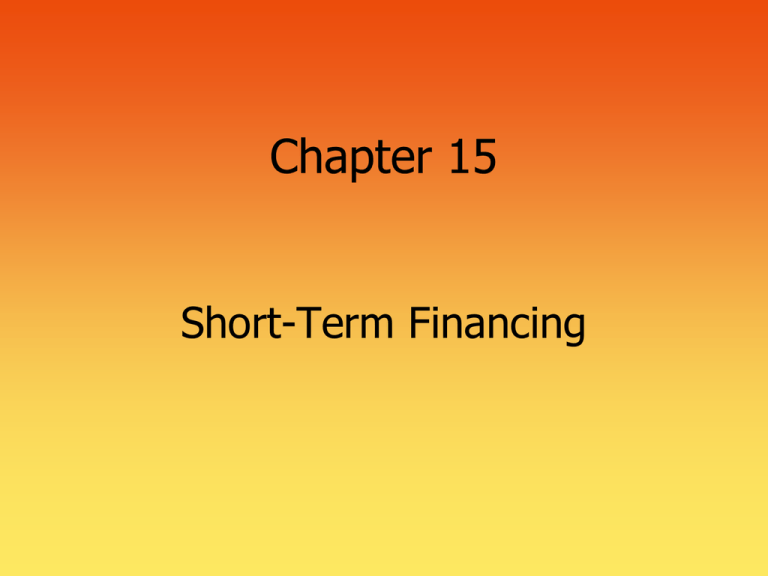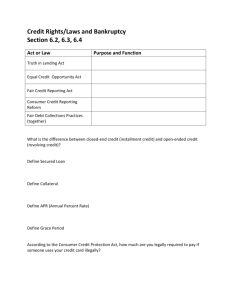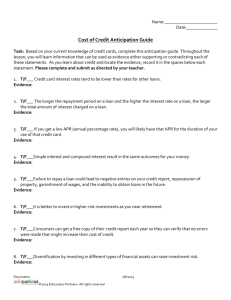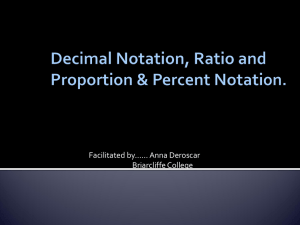Chapter 1 An Overview of Managerial Finance
advertisement

Chapter 15 Short-Term Financing Learning Objectives The need for short-term financing. The advantages and disadvantages of short-term financing. Three types of short-term financing. Computation of the cost of trade credit, commercial paper, and bank loans. How to use accounts receivable and inventory as collateral for short-term loans. 2 Why Do Firms Need Shortterm Financing? Cash flow from operations may not be sufficient to keep up with growth-related financing needs. Firms may prefer to borrow now for their inventory or other short term asset needs rather than wait until they have saved enough. Firms prefer short-term financing instead of longterm sources of financing due to: easier availability usually has lower cost (remember yield curve) matches need for short term assets, like inventory 3 Sources of Short-term Financing Short-term loans. borrowing from banks and other financial institutions for one year or less. Trade credit. borrowing from suppliers Commercial paper. only available to large credit- worthy businesses. 4 Types of short-term loans: Promissory note A legal IOU that spells out the terms of the loan agreement, usually the loan amount, the term of the loan and the interest rate. Often requires that loan be repaid in full with interest at the end of the loan period. Usually with a Bank or Financial Institution; occasionally with suppliers or equipment manufacturers 5 Types of short-term loans: Line of Credit The borrowing limit that a bank sets for a firm after reviewing the cash budget. The firm can borrow up to that amount of money without asking, since it is preapproved Usually informal agreement and may change over time Usually covers peak demand times, growth spurts, etc. 6 Trade Credit Trade credit is the act of obtaining funds by delaying payment to suppliers, who typically grant 30 days to pay. The cost of trade credit may be some interest charge that the supplier charges on the unpaid balance. More often, it is in the form of a lost discount that would be given to firms who pay earlier. Credit has a cost. That cost may be passed along to the customer as higher prices, (furniture sales, Office Max), or borne by the seller as lower profits, or some of both. 7 Estimation of Cost of Short-Term Credit Calculation is easiest if the loan is for a one year period: Effective Interest Rate is used to determine the cost of the credit to be able to compare differing terms. Effective = Cost (interest + fees) Interest Rate Amount you get to use Example: You borrow $10,000 from a bank, at a stated rate of 10%, and must pay $1,000 interest at the end of the year. Your effective rate is the same as the stated rate: $1,000/$10,000 = .10 = 10% 8 Variations in Loan Terms A discount loan requires that interest be paid up front when the loan is given. This changes the effective cost in the previous example since you only get to use: ($10,000 - $1,000) = $9,000. Effective rate (APR) = $1,000/$9,000 = .1111 = 11.11%. 9 Variations in Loan Terms Sometimes lenders require that a minimum amount, called a compensating balance be kept in your bank account. It is taken from the amount you want to borrow. If your compensating balance requirement is $500, then the amount you can use is reduced by that amount. Effective Rate (APR) for a $10,000 simple interest 10% loan with a $500 compensating balance = $1,000/($10,000-$500) = .1053 = 10 10.53%. Both Discount Interest and Compensating Balance Sometimes, lenders will require both discount interest (paid in advance) and a compensating balance. If the interest is $1,000 and the compensating balance is $500, then the effective rate (APR) becomes: $1,000 / $10,000 - $1,000 - $500 $1,000 / $8,500 = 11.76% 11 Cost of Short Term Credit Cost of Trade Credit Typically receive a discount if you pay early. Stated as: 2/10, net 60 Purchaser receives a 2% discount if payment is made within 10 days of the invoice date, otherwise payment is due within 60 days of the invoice date. The cost is in the form of the lost discount 12 if you don’t take it. Calculating APR (same as EIR) $ Interest = Rate x Principle x Time i.e. Int = 6% x $1,000 x 90/360 = $15 APR = $ Interest (cost) x 1 $ Net Borrowed Time APR = $15 x 1 / 90 = 1.5% x 4 = 6.0% $1,000 360 Say you have a loan fee of $5.00, then APR = $15 + $5 x 1/90 = 2.0% x 4 = 8.0% 1,000 360 13 Cost of Trade Credit 2/10 net 60 Assume your purchase is $100 list price. If you take the discount, you pay only $98. If you don’t take the discount, you pay $100. Therefore, you (buyer) are paying $2 for the privilege of borrowing $98 for the additional 50 days. (Note: the first 10 days are free in this example). APR = $2/$98 x 365/50 = 14.9% (If you pay in 60 days) What if 2%/10, net 30 APR = $2/$98 x 365/20 = 37.25%! (If you pay in 30 days) 14 Commercial Paper Commercial paper is quoted on a discount basis, meaning that the interest is subtracted from the face value to arrive at the price. See 3 steps below for calculation: Step 1: Compute the discount (D) from face value of the commercial paper Discount (D) = (Discount rate x par x DTG)/365 DTG = days to go (to maturity) Step 2: Compute the price = Face value - Discount Step 3: Compute Effective Annual Rate (APR): $ interest you pay/ $ you get to use 15 Cost of Commercial Paper Example $1 million issue of 90 day commercial paper quoted at 4% discount rate. Step 1: Calculate D = .04 x $1 mill. x 90 = $10,000 360 Step 2: Calculate price (amount you get) Step 3: Calculate effective rate (APR) = $1,000,000 - $10,000 = $990,000 = $10,000 / $990,000 = 1.010% x 4 = 4.04% 16 Accounts Receivable as Collateral A pledge is a promise that the borrowing firm will pay the lender any payments received from the accounts receivable collateral in the event of default. Since accounts receivable fluctuate over time, the lender may require certain safeguards to ensure that the value of the collateral does not go below the balance of the loan. So, normally a bank will only loan you 70 -75% of the receivable amount Accounts receivable can also be sold outright. This is known as factoring. 17 Cost of Borrowing against Receivables Average monthly sales = $100,000 60 day terms, so average Acct Rec balance = $200,000 Bank loans 70% of Accts Rec = $140,000 Interest is 3% over prime (say 8%) = 11% x $140,000 = $15,400 1% fee on all receivables = 1% x $100,000 x 12 = $12,000 APR = $15,400 + $12,000 x 1/1 = 19.57%! $140,000 18 Inventory as Collateral A major problem with inventory financing is valuing the inventory. For this reason, lenders will generally make a loan in the amount of only a fraction of the value of the inventory. The fraction will differ depending on the type of inventory. If inventory is long lived, i.e. lumber, they (lender or a customer) may loan you up to 75% of the resale value. If inventory is perishable, i.e., lettuce, you won’t get much 19






